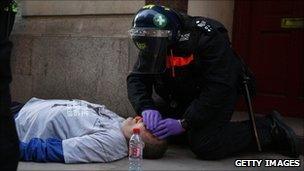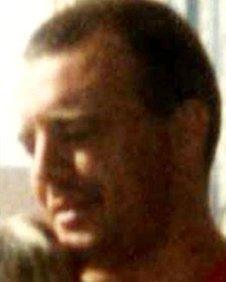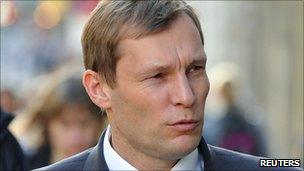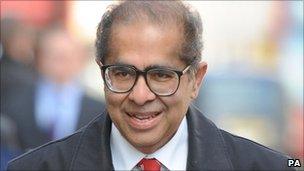Key people: Death of Ian Tomlinson during G20 protests
- Published

Ian Tomlinson was treated by police medics but died shortly after collapsing
An inquest jury has ruled that Ian Tomlinson was unlawfully killed by a Metropolitan Police officer during the G20 protests in 2009.
The 47-year-old collapsed and died shortly after being pushed to the ground by Pc Simon Harwood.
Here, BBC News looks at some of the key people involved in the case.
Ian Tomlinson
The 47-year-old spent his final day as he spent most days - helping out newspaper vendors around Monument Underground station.

Ian Tomlinson collapsed minutes after being pushed to the ground
After his death, those vendors expressed sadness at his loss, describing him as "a gentleman" who "never hurt anyone".
Born in Derbyshire, Mr Tomlinson moved to London as a young man. He married his wife Julia in 1991 and the couple had four daughters. Mr Tomlinson also become stepfather to his wife's five other children.
The Evening Standard reported that he had been homeless for a number of years and had a long-term problem with alcohol. That had left him with health problems including cirrhosis of the liver.
Mr Tomlinson was walking back to a hostel near Smithfield Market, where he had been living, when he was caught up in the G20 protests.
Video footage of his last moments shows him wearing his beloved Millwall football shirt and walking with his back to a line of police officers.
Suddenly, one officer lunges forward and pushes him to the ground. He gets up, but minutes later collapses in a nearby street. Despite the efforts of police medics, he died a short while later.
The inquest was told blood tests showed Mr Tomlinson was five times over the legal drink-drive limit at the time of his death.
Pc Simon Harwood

Pc Simon Harwood gave evidence to the inquest over three days
The push that knocked Mr Tomlinson to the ground was delivered by Metropolitan Police officer Pc Simon Harwood.
A member of the territorial support group, based in Lambeth, south London, he was acting as a driver on the day of the G20 demonstrations. The inquest was told he left his vehicle after attempting to make an arrest.
Following Mr Tomlinson's death, Pc Harwood was questioned on suspicion of manslaughter, but eventually the Crown Prosecution Service decided not to bring any charges against him.
He has, however, been suspended from duty since April 2009, and is due to face internal disciplinary proceedings.
Papers served ahead of those proceedings accuse him of using force that "was not necessary, proportionate or reasonable in the circumstances", and that "inadvertently caused or contributed" to Mr Tomlinson's death.
At the inquest, Pc Harwood apologised to the Tomlinson family for "any way" he may be responsible for the death.
He said Mr Tomlinson was not a threat but had been ignoring other officers' requests for him to move on.
PC Harwood said he pushed the newspaper seller after a strike on the thigh had failed to move him.
But he told the jury he saw his actions as "proportionate" and had been "amazed" that Mr Tomlinson fell forward after the "poor push".
The jury concluded that Pc Harwood unlawfully killed the newspaper seller.
It decided the policeman used "excessive and unreasonable" force in striking Mr Tomlinson.
Jurors also said the newspaper seller, who was not taking part in the protests, posed no threat.
Dr Freddy Patel
Dr Mohmed Saeed Sulema Patel - known as Freddy - was a Home Office-registered pathologist at the time of the G20 protests.
After Ian Tomlinson died he carried out the post-mortem examination, and came to the conclusion that he died of natural causes - from a heart attack - linked to coronary artery disease.
However, once it emerged that Mr Tomlinson had been pushed to the ground before his death, a second autopsy was ordered.

Dr Freddy Patel concluded that Mr Tomlinson died of natural causes - other pathologists disagreed
It concluded that he had died following an abdominal haemorrhage caused by some kind of blow.
But Dr Patel told the inquest he could not establish a "causal link" between the police incident and his death.
It was this disagreement between experts that the CPS blamed for their decision not to bring any charges.
Dr Patel qualified in Zambia and registered as a doctor in the UK in 1988.
During his career, he has been brought before the General Medical Council (GMC) on several occasions as a result of professional failings.
In 1999, he was disciplined after he discussed the private medical history of Roger Sylvester - who died in police custody - with reporters.
In July 2009, following the Tomlinson case, he was removed from the Home Office register of pathologists.
Just over a year later, the GMC found him guilty of misconduct in relation to the post-mortem examinations of three children, and suspended him for three months.
In March 2011, he was again found guilty of gross misconduct over a case involving murder victim Sally White, and was suspended for four months.
He wrongly concluded she had died of natural causes - a decision the GMC was told discouraged a police investigation that might have saved two other women subsequently killed by the same man.
Dr Nat Cary
One of the country's most senior pathologists, Dr Nat Cary carried out the second post-mortem examination on Mr Tomlinson's body on behalf of the Independent Police Complaints Commission and the dead man's family.

Dr Cary was involved in the trials of Soham murderer Ian Huntley and Suffolk serial killer Steve Wright
He was called in after doubts were raised about Dr Patel's verdict and subsequently came to a very different conclusion - that Mr Tomlinson had died from internal bleeding in the abdomen.
Dr Cary told the inquest that was the only "realistic possibility" for Mr Tomlinson's death and was a consequence of him being pushed over.
He said the video footage suggested Mr Tomlinson's elbow could have been trapped between his abdomen and lower chest as he fell, causing a "blunt force trauma" injury.
Dr Cary has carried out a number of high-profile autopsies and been called on to give expert evidence in several major trials.
He first came to public attention when he disproved the claim by Soham murderer Ian Huntley that Holly Wells and Jessica Chapman had died in a freak accident in his bath.
He later worked on the Suffolk prostitute killings - discrediting a claim by culprit Steve Wright that one of the women had died accidentally during a sex game - and also solved the mystery surrounding the sudden death of Pakistan cricket coach Bob Woolmer.
Dr Kenneth Shorrock
Dr Kenneth Shorrock conducted a third post-mortem examination on Mr Tomlinson. The inquest heard his report had "independently come to very similar conclusions" to those of Dr Cary.
The procedure was performed at the request of the Metropolitan Police.
Dr Ben Swift
Dr Ben Swift conducted a fourth post-mortem examination on Mr Tomlinson. The procedure was performed at the same time as Dr Kenneth Shorrock and at the request of lawyers acting for Pc Simon Harwood.
Dr Swift also agreed with Dr Cary's findings and he was not called to give evidence at the inquest.
Peter Thornton QC

Peter Thornton QC is an expert in public order law
Senior judge Peter Thornton QC is an expert in public order law and has been involved in a number of high-profile trials.
He was appointed assistant deputy coroner for the Tomlinson case in November, replacing City of London Coroner Paul Matthews.
That move was made after Mr Matthews reportedly wrote to ministers stressing the national significance of the case and, therefore, the need to have a very experienced person at the helm.
Coroners have been replaced by senior judges in a number of complex, high-profile inquests in recent years, including those into the deaths of the Princess of Wales, Jean Charles de Menezes (the Brazilian electrician who in 2005 was shot dead on a London Underground train by police who mistook him for a suicide bomber) and the victims of the 7 July attacks.
According to the Tomlinson inquest website: "Because of the exceptional circumstances of this death it was thought sensible to have a senior judge to conduct the inquest."
Mr Thornton is a founder member of London's Doughty Street chambers and was appointed as senior judge at the Old Bailey in 2007.
He is the co-author of a highly respected reference work on public order and protest law.
Christopher La Jaunie
Christopher La Jaunie took video footage on a compact digital camera that showed Mr Tomlinson being pushed by Pc Simon Harwood.
The American portfolio manager told the inquest Mr Tomlinson caught his attention as he had been trying to get through a line of police officers with dogs while other people were backing away.
Mr La Jaunie, who had been standing about 25ft (8m) away, said he contacted the media when news reports about a fatality at the protest did not mention a man had been pushed.
- Published19 July 2012
- Published5 August 2013